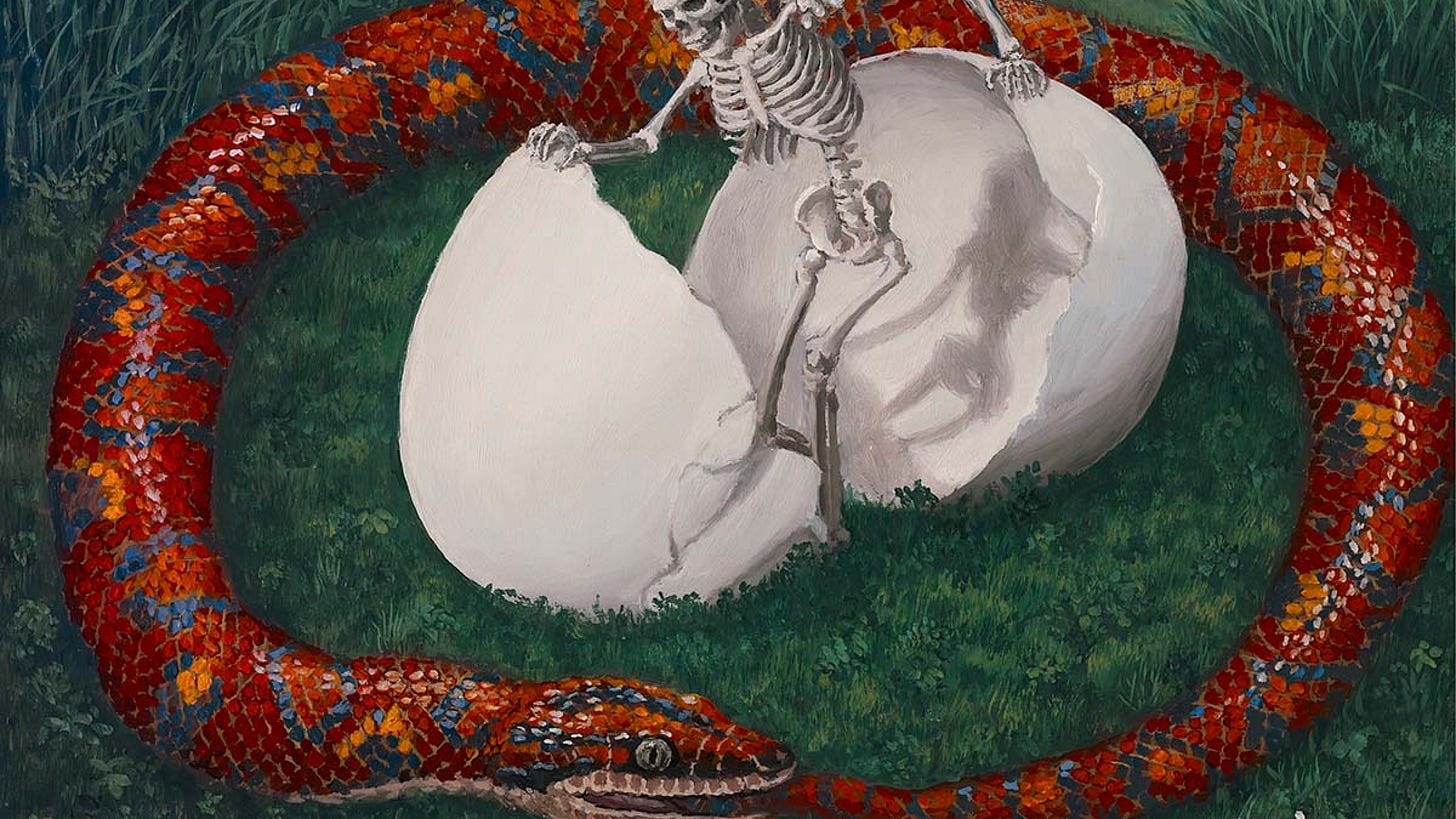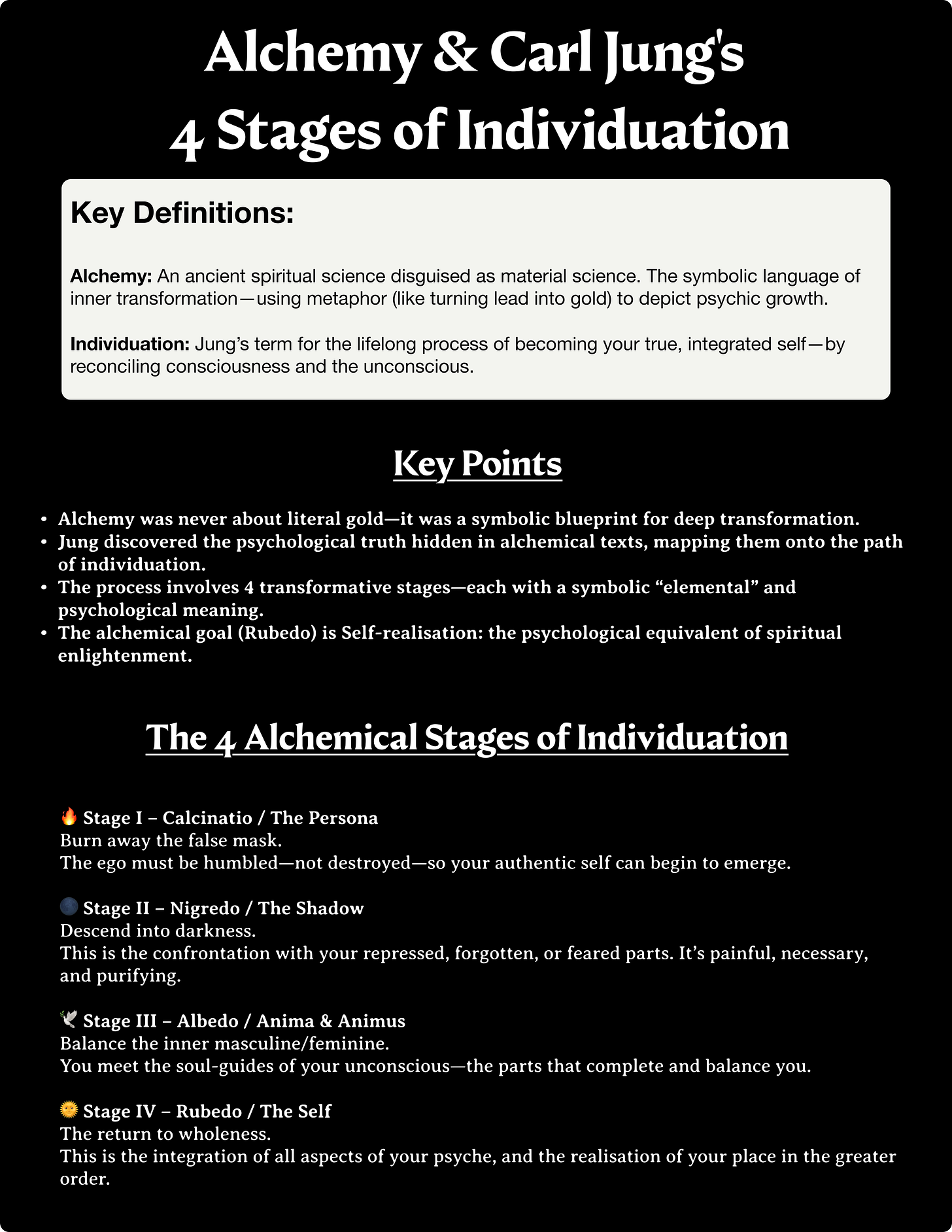Alchemy & Carl Jung's 4 Stages of Individuation
A beginners' guide to medieval alchemy and self-realisation (+ DOWNLOADABLE SUMMARY 📝)
“The secret is that only that which can destroy itself is truly alive”
– C.G Jung, ‘Psychology and Alchemy,’ para. 93
Alchemy was never about gold.
(Not literal gold anyway). It’s a form of medieval mysticism that used esoteric language and symbolism to hide heretical beliefs from the Church. The alchemist was a rare kind of philosopher. Taboo held no weight, and truth was sought above appearances.
Beyond truth, transformation was the ultimate goal.
We’re not talking about “wake up 5:30 and hit the cold plunge” kind of transformation.
But the real thing. Shame and obligation wash away to reveal the contentment and voluntariness of authentic living. Famous psychologist, Carl Jung, had the same thing in mind when he proposed his theory of Individuation:
The lifelong process of incorporating unconscious elements with consciousness to realise the true self.
This is his psychological interpretation of the spiritual/religious path.
“Individuation . . . is the process by which individual beings are formed and differentiated; in particular, it is the development of the psychological individual as a being distinct from the general, collective psychology. Individuation, therefore, is a process of differentiation, having for its goal the development of the individual personality”
– C.G. Jung, ‘Psychological Types,’ para. 757
8 years later he read The Secrets of the Golden Flower (a Chinese alchemical text).
The similarities to his own philosophy knocks him down.
He falls down the alchemical rabbit hole. He becomes (likely) the best read man of his age in alchemy, uses his genius to interpret the symbology, and incorporates it into his own school of psychology.
It’s speculated that without Jung, alchemy wouldn’t be in the modern parlance.
Here’s Alchemy & Carl Jung's 4 Stages of Individuation…
(See end for downloadable summary 📝)
Stage I: Calcinatio / Persona Realisation
Calcinatio is a kind of “burning away” of the superficial personality.
A persona was a mask worn by Roman actors; it came to symbolise “playing a part”: “Fundamentally the persona is nothing real: it is a compromise between individual and society as to what a man should appear to be” (C.G. Jung).
It is the mask we wear for society.
It’s a necessary part of development.
But as we mature, it becomes more inhibitor than enabler. It’s heavily entwined with Ego (our sense of ‘I’). A philosophy, belief, or guru that tells you to “kill your ego” is a fraudulent one.
“Killing your ego is the biggest ego-trip going”
– Alan Watts
Not only is it impossible, but very undesirable.
Our ego and persona are what enable us to operate and cooperate in the world.
Jungian psychology seeks to cut the ego down to size (nothing more). The ego is only dangerous when it forgets it’s only a useful illusion; the persona is only a problem when it blocks the core personality from emerging.
Stage II: Nigredo / Shadow Integration
This is deeper and hotter version of stage I.
“That can burn is us, should burn” (Robert A. Johnson)
The Shadow is the accumulation of everything that deserves awareness, that you’ve either actively denied or forgotten. A confrontation with it is a confrontation with our dark side. This is a lonesome period in life where you’re met with loss, death, and failure as the world you knew is proven false.
The Spanish monk, St John of the Cross, termed it “the dark night of the soul.”
The aim is a maturation of soul; a humbling.
You have to face reality as it is; remember the things you want to forget; take the actions you’ve been putting off. As punitive as it sounds, it’s not meant as a punishment
From the ashes of your old mode of being something new is born.
Stage III: Albedo / Anima or Animus Integration
“The anima is the archetype of life itself” (C.G. Jung)
The Anima is the feminine in man.
The Animus is the masculine in woman.
It is the necessary and eternal opposite of our dominant way of being. Once we’ve dredged through our own darkness, a potential for light appears (albedo = whitening). These soul guides want us to balance.
The hard masculine needs to soften.
The soft feminine needs to harden.
This puts us in touch with the androgynous nature of the universe. Alchemy was once known as “lower astrology,” the idea being that the mystical idea of macro and microcosm were still acknowledged. It was believed as souls descended from the heavens, many differentiations took place: one being the segregation of gender.
You see this hinted at with divinities like:
Jesus
Krishna
The Buddha
All possess subtle feminine features.
But symbology by definition is not literal, and this is talking about psychology (not a real transgendering).
Stage IV: Rubedo / Self-Realisation
Rubedo is a reddening.
A fiery return from the ashes towards new life and purpose. Hidden and scattered through the unconscious psyche, Jung believed a powerful archetype subsided: the Self. The core of your being. The driving force behind the trajectory of your life, and your place in it.
Realising the Self is a realisation of God and the greater meaning in the universe.
Gnosis
Enlightenment
Going to Heaven
There are many words for it.
But there is only one path, and it is unique to you.
“In all chaos there is a cosmos, in all disorder a secret order”
– C.G. Jung, ‘Archetypes and the Collective Unconscious,’ para. 66
📝 Summary (DOWNLOAD)
That’s it!
Let me know your thoughts.
If you liked it, you’ll love this one about The Dangers of Not Listening to Your Unconscious
Jungian psychology is a powerful tool for life.
But getting started can be a:
Slow
Confusing
Frustrating process
After 5+ years of study, and reading 25+ major titles, I’ve put together a FREE resource to help people avoid overwhelm.
📚 Core ideas that can be applied right away 📩 Delivered in 5 easy and short lessons 🧠 Great foundation for further study ⭐️ Plus, you’ll get:
Digital assets and a tracker
A curated further reading list
Curious?






